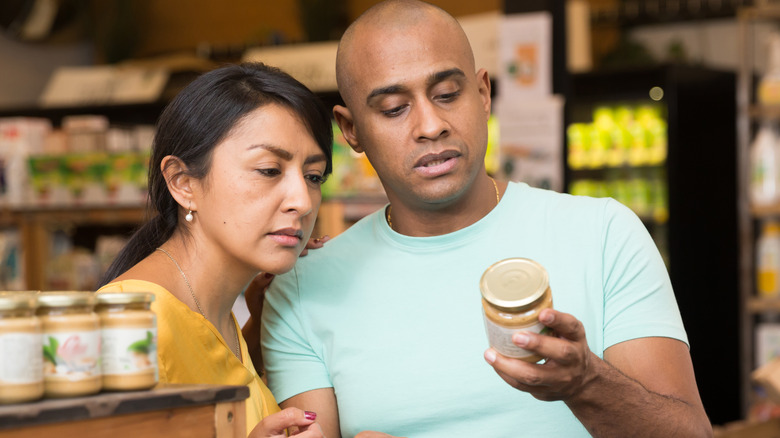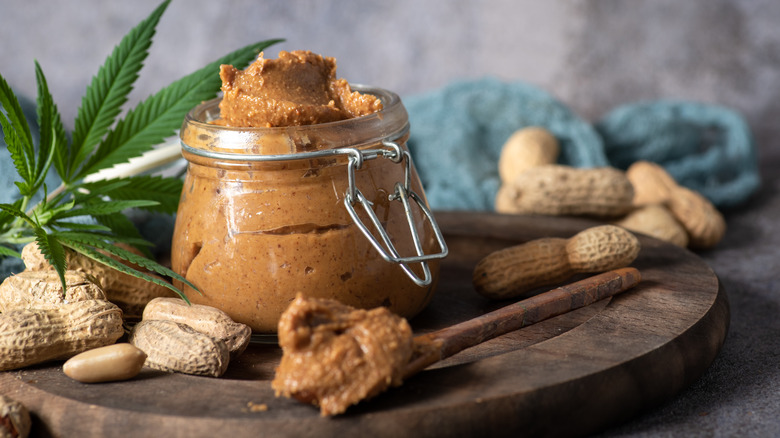Avoid Eating Low-Fat Peanut Butter If You Have This Medical Condition
During the low-fat diet craze, food manufacturers came up with alternate versions of traditionally high-fat products, such as low-fat ice cream (yuck), low-fat potato chips (remember the fart-inducing Olestra?), and low-fat butter spread.
Even peanut butter came out with reduced fat versions, with many of them cutting back about 25% of the fat compared to regular peanut butter. However, when food manufacturers cut back on peanuts, it means adding sugars and other strange ingredients that your body doesn't necessarily like.
Although low-fat or reduced-fat peanut butter won't cause a spike in your blood sugar because of the protein, fat, and fiber, people with diabetes might want to avoid these peanut spreads because they're ultra-processed. Ultra-processed foods are those that have ingredients that you won't find in a typical kitchen or additives that enhance the flavor or texture of a product.
According to a 2023 study in the American Journal of Clinical Nutrition, people with type 2 diabetes whose diets were high in ultra-processed food had a 70% higher all-cause mortality risk and more than twice the risk of dying from cardiovascular disease compared to those whose diets were lower in ultra-processed food.
The artificial ingredients in low-fat peanut butter
A two-tablespoon serving of Better'n Peanut Butter has just 100 calories and 2 grams of fat, but there are also 6 grams of sugar and 2 grams of added sugar. Although grounded peanuts are the first ingredient, the next two ingredients are brown rice syrup and tapioca syrup, which are added sugars. You'll also find vegetable glycerin, titanium dioxide, and soy lecithin in this ultra-processed version of peanut butter.
Jif's reduced-fat peanut butter spread might save you a little bit of fat, but the second ingredient is corn syrup solids. This sandwich spread also has hydrogenated vegetable oil, magnesium oxide, ferric orthophosphate, and pyridoxine hydrochloride.
You'd probably do a little better with PBfit peanut butter spread, even though it isn't low in fat. You still have 3 grams of sugar and 2 grams of added sugar from coconut palm. However, this spread has five total ingredients that you can pronounce, even though you might not find pea protein in your pantry.
Rather than choose these ultra-processed foods, you might be better off reaching for an all-natural peanut butter like Smucker's, which has two ingredients–peanuts and salt. If you're looking to reduce your saturated fat, try these peanut butter alternatives.
Choose less processed foods to control your blood sugar
Even if you don't have a problem with diabetes now, highly processed foods pose a risk to your health in the future. A 2022 meta-analysis in the International Journal of Epidemiology found a strong association between ultra-processed foods and your risk of diabetes. Diets high in ultra-processed food lead to a 31% increased risk of diabetes. You'll want to limit not only low-fat peanut butter spreads but also sugary drinks, refined carbs, foods with added sodium, and red and processed meats. Opt for whole foods such as fruits, vegetables, fish, poultry, beans, and nuts.
Natural peanut butter made from just peanuts and maybe salt can actually control your blood sugar, according to a 2019 study in the Journal of the American College of Nutrition. While you might feel signs that your blood sugar is spiking after a breakfast of white bread and apple juice, adding 2 tablespoons of peanut butter to that meal minimized the blood sugar spike and overall glycemic response.



